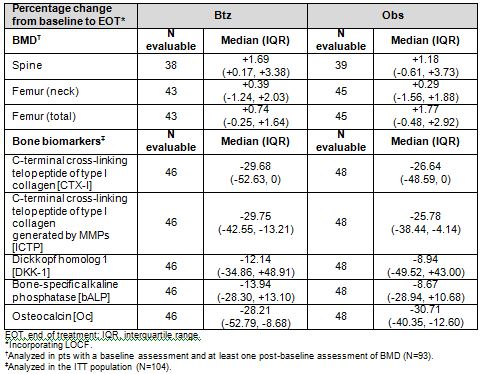Konference: 2014 19th Congress of the European Hematology Association - účast ČR
Kategorie: Mnohočetný myelom
Téma: Myeloma and other monoclonal gammopathies - Clinical (Poster)
Číslo abstraktu: P960
Autoři: Orhan Sezer; prof. MD Meral Beksac; prof. MUDr. Roman Hájek, CSc.; M.D. Gülsan Türköz Sucak; Seckin Cagirgan; Univ.-Prof. Dr.med.univ. Werner Linkesch; Prof. Olga Meltem Akay; Gabriele Armbrecht, Ph.D.; MD Torben Plesner; Prof. John A. Snowden; Hareth Nahi; Zafer Gulbas; Anna Potamianou; PharmD Catherine Couturier; Robert Olie; Caroline Feys; Nathalie Allietta; Evangelos Terpos
ABSSUB-4589
Background: Lytic bone destruction is a debilitating manifestation of MM. In addition to its anti-MM activity, data suggest that Btz inhibits osteoclastogenesis and stimulates osteoblast activity, exerting positive effects on bone metabolism that may be bone-specific and independent of the effects on MM. This is the first randomized study of Btz with a bone-specific endpoint.
Aims: This study is evaluating the effects of Btz consolidation vs observation (Obs) on bone health in newly diagnosed MM patients (pts) who underwent prior high-dose therapy with autologous stem cell transplant (HDT-ASCT) (NCT01286077). Primary endpoint was baseline to end-of-treatment (EOT) change in bone mineral density (BMD). Secondary endpoints included changes in bone biomarkers, skeletal events, new bone lesions, and safety.
Methods: Consenting adults with newly diagnosed MM who had achieved partial response or better (≥PR) after single/double HDT-ASCT were eligible. Pts were randomized 1:1 (stratified by age [<65 vs ≥65 yrs] and baseline bisphosphonate [BPP] use), to 4 x 35-d cycles of Btz 1.6 mg/m2 IV on d 1, 8, 15, 22, or Obs alone. BMD was measured in spine/femur at baseline, after 2 cycles, and at EOT by dual energy X-ray absorptometry; data were centrally assessed. Serum samples were acquired at these same time points for bone biomarker and M-protein measurement. For pts with missing assessments, a last observation carried forward (LOCF) approach was used. Response was assessed by IMWG 2009 criteria. Adverse events (AEs) were graded by NCI-CTCAE v3.0. Analysis was mainly by intent-to-treat (ITT), including all randomized pts who received ≥1 dose of Btz (Btz arm), and in pts who had a baseline and ≥1 post-baseline BMD assessment.
Results: Between July 2009 and May 2012, 106 pts from 8 countries were randomized (52 Btz, 54 Obs). The ITT population included 104 pts (51 Btz, 53 Obs); median age 58 vs 57 yrs, 12% vs 15% aged ≥65 yrs, 65% vs 58% male, 77% vs 74% baseline BPP use. A similar proportion of pts in the Btz (71%) and Obs (66%) arms had received Btz-based induction prior to HDT-ASCT. Post-HDT-ASCT, rates of complete response [CR]/PR were 16%/82% (Btz) and 15%/83% (Obs). 78% vs 85% of pts completed Btz consolidation and Obs, respectively. Baseline characteristics were generally well balanced between arms, but 69% (Btz) vs 75% (Obs) of pts received BBPs; 39% vs 60% zoledronic acid and 29% vs 19% pamidronic/ibandronic/clodronic acid. Median baseline to EOT change in BMD is shown in the table; no differences were observed between the arms regardless of age or baseline BPP use. Further, there were no differences between the arms in median baseline to EOT change in bone biomarkers (Table), or incidence of skeletal events or number of new bone lesions. Post-consolidation rates of CR/PR/progressive disease [PD] were 22%/69%/8% (Btz) and 11%/66%/21% (Obs). Rates of grade ≥3 AEs were 10% (Btz) vs 6% (Obs) and serious AEs 12% (Btz) vs 6% (Obs); no new safety signals for Btz were observed.

Summary/Conclusion: Single-agent Btz consolidation and Obs produced comparable changes in BMD and bone biomarkers. Btz consolidation was generally well tolerated, and appeared to improve response depth relative to post-ASCT response and reduce PD rates. Prior Btz-based induction, prior HDT-ASCT, and concomitant BPP use represent possible confounding factors in this analysis. Long-term follow-up is ongoing.
Keywords: Bone Density, Bortezomib, Consolidation, Myeloma
Datum přednesení příspěvku: 14. 6. 2014





